Just heard the sad news that the great artist Sam Gilliam has died.
Last week I wrote about Sam's first ever major museum show in DC area. My feelings here.
Since 2003... the 11th highest ranked art blog on the planet! And with over SIX million visitors, F. Lennox Campello's art news, information, gallery openings, commentary, criticism, happenings, opportunities, and everything associated with the global visual arts scene with a special focus on the Greater Washington, DC area.
Just heard the sad news that the great artist Sam Gilliam has died.
Last week I wrote about Sam's first ever major museum show in DC area. My feelings here.
Over the decades that I have lived in the DMV (an acronym that I invented), one constant of the DMV's museum art scene (with the exception of the beautiful American University art museum and most recently the Phillips Collection) has been the immense apathy that art museums located in the capital region show to their area artists.
Once, while a guest at the old Kojo Nmandi radio show on NPR (WAMU), i noted that it was "easier for a DC area museum curator to take a cab to Dulles to catch a flight to Berlin to visit some emerging artists' studios in Berlin (or London, Madrid, wherever) than to catch a cab to Adams Morgan to visit a DC area emerging artist studio."
Years of communicating this frustration to "new" museum curators and directors as the wonder in and out of their positions at the Hirshhorn, the old Corcoran, various Smithsonian museums, all area University museums, etc. have yielded zero response -- since 1992 or so, the only museum director who ever met with me to discuss why their museum ignored local artists was Olga Viso when she ran the Hirshhorn decades ago.
And it takes an artist of the stature of Sam Gilliam, whose career was almost extinguished by apathy just a decade or so ago... until "rediscovered" by New York and other forces and placed where this great artist always deserved to be - at the top - the "break" into a local museum with an exhibition which should have happened years and years ago.
Hirshhorn: Thank you for exhibiting Sam Gilliam and shame on you that it took outside forces to make this happen.
Hirshhorn’s Sam Gilliam Exhibition Will Spotlight His Decades-Long Investigation Into Abstraction
“Sam Gilliam: Full Circle” Will Debut New Paintings, May 25–Sept. 4
This spring, the Hirshhorn Museum and Sculpture Garden will present an exhibition by pioneering abstractionist artist Sam Gilliam. Between May 25 and Sept. 4, “Sam Gilliam: Full Circle” will pair a series of circular paintings (or tondos) created in 2021 with “Rail” (1977), a landmark painting in the Hirshhorn’s permanent collection. Filling the museum’s second-floor inner-circle gallery, Gilliam’s first solo exhibition at the Hirshhorn will reflect the breadth of his multilayered practice and mark the first exhibition in Gilliam’s chosen hometown of Washington, D.C., since 2007. “Full Circle” is organized by Evelyn C. Hankins, the Hirshhorn’s head curator.
In the 60 years since moving to Washington, Gilliam has produced a prolific body of abstraction across media through which he has continually pursued new avenues of artistic expression. He initially rose to prominence in the late 1960s making large, color-stained manipulated, unstretched canvases. Gilliam continues to experiment with staining, soaking and pouring pigments, elaborating on the process-oriented tradition of Morris Louis, Kenneth Noland and other Washington Color School artists. In 1972, Gilliam represented the United States at the 36th Venice Biennale, and returned in 2017 with “Yves Klein Blue,” a draped work that welcomed visitors to the Venice Giardini. Gilliam’s approach focuses keenly on the cornerstones of abstraction—form, color and material—from which he creates artworks that reflect his career-long engagement with art history and the improvisatory ethos of jazz.
“The Hirshhorn’s institutional support for Sam Gilliam began with the acquisition of his landmark painting “Rail” within a year of its creation,” said Hirshhorn Director Melissa Chiu. “The museum has since championed his practice by presenting this and other major works in exhibitions. “Full Circle” shows Gilliam’s most recent works in recognition of his indefatigable vision, presented in his chosen hometown on the National Mall at the national museum of modern art.”
“I am greatly looking forward to premiering this new body of work,” Gilliam said. “The tondo series introduced in this show encapsulate many of the ideas that I have been developing throughout my career. Just as importantly, they reflect my current thinking about color, materials, and space. These spaces determined by color and texture are limitless.”
Sam Gilliam’s most recent engagement with the Hirshhorn reflects his tireless propulsion of the through lines of abstraction. His tondos expand the body of beveled-edge abstract paintings that Gilliam first pioneered in the 1960s. Ranging in size from 3 to 5 feet in diameter, each tondo begins with a beveled wood panel, which the artist loads with layers of dense, vibrant pigments, their aggregate effect heightened through the addition of thickening agents, sawdust, shimmering metal fragments, wood scraps and other studio debris. Using a stiff metal rake along with more traditional tools, Gilliam then abrades, smears and scrapes the coarse surfaces to reveal a constellation of textures and colors below.
The series will be shown alongside “Rail” (1977), a stellar “Black” painting by Gilliam in the Hirshhorn’s collection work that marks some of the artist’s earliest experiments with pronounced materiality. With its immense scale of more than 15 feet in length, stained underpinning, pieced canvas structure and deep tones, “Rail” offers a resonant counterpoint to the artist’s recent tondos.
I'm pleased to announce that the Yuri Schwebler curatorial project I have been working on the last few years is “open," and that the catalog is now available online.Although originally scheduled to open in June, because of the pandemic the American University Museum canceled all their summer exhibitions. As a result, I offered to create a virtual exhibition (fancy words for "slideshow") to substitute for what was no longer going to be on exhibit. You can find links to the slideshow, and the exhibition catalog, on the museum's exhibition page.This exhibition is, in many respects, an extension of my earlier Jefferson Place Gallery research, which has expanded to included monographs of Hilda Thorpe, Mary Orwen, and Jennie Lea Knight (each at Marymount University, co-curated with Meaghan Kent and Caitlin Berry), and a catalog essay about Rockne Krebs and Sam Gilliam, for Day Eight's exhibition Built and Unbuilt.
On Thursday, at 12:30 Eastern, there is a virtual discussion between the Museum's Director, Jack Rasmussen, and myself. Registration can also be found on the exhibition page.
The two Clayton women shared a home and an appetite for collecting, spending nearly 50 years buying works by Black artists from auctions, galleries, and thrift shops.Read the article in Artsy here.
I’m going to argue your point about the halcyon days, Lenny, and say it was during the 1970s..There were about 120 galleries in DC (not DMV) at one point, and GREAT coverage in the Post and Star. (I can’t recall if Washington Daily News was still active, or the Virginia Morning Sun; the area had 4 dailies going into the 1960s, though). Hopps was absorbing DC artist works into the NCFA (now SAAM). Slade made the Corcoran healthy (and did so without breaking anyone’s nose). The Phillips was actively exhibiting local artists. The WPA opened and had three floors of crazy going on. The Hirshhorn opened. The NEA supported several area artists. There were the women’s artists conferences. The Bicentennial. Artists fighting for rights on The Hill. Rockne was shooting his lasers everywhere. The Art Now (1974) scandal. Yuri Schwebler’s Sundial. Exciting times! I won’t disagree that the 80s, 90s, 00s were all interesting, exciting, or brimming with potential. But I think the 70s was peak awesome in DC art history, and it was predicated by a scene that was growing in the 1950s and 1960s (something Andrew Hudson recognized in an exhibition he curated for the Edmonton Art Gallery in 1970, and something another curator in Baltimore recognized for a similar exhibition at the BMA: both opening in 1970, I believe).
It’s unclear from Bourland’s historical synopsis if he deemed the 70s as the hay-day, since he folds the 50s-60s Color School (WCS) in with Protetch, Moyens, Henri, etc... However, the omission of the Jefferson Place Gallery (JPG) struck me as interesting. I mean, if he’s going to mention WCS, he may as well credit the gallery that, at one time, supported Noland, Davis, Downing, and Mehring (the latter of which exhibited at the JPG at least through 1971). If he is going to mention Gilliam, again he may as well mention the JPG since Gilliam showed there from 65-74. In fact, every artist Bourland mentioned had some connection to JPG, whether being represented by or, in the case of Louis, eschewing invitation to do so.
The mention of “hard-edged abstraction of the Washington Color School anchored by Louis and Gilliam” also made me laugh. I mean, those are the two guys who are least hard edge (minus Gilliam’s first stripes). Come to think of it, Noland’s targets weren’t all that hard-edged, and Mehring’s best work—his dappled all-overs—also defied hard edges. The three who were most consistently hard edge were Downing, Davis, and most especially Truitt! Can’t get much harder-edged than the side of a rectangular prism.
There are other issues with his historical truncation, which make me wonder if it was just slap-dash editing, or some concession to word count. For instance, why was Bill Christenberry lumped in with the Color School guys? His stuff seems charged by memory, place, nostalgia, and time. In other words: content... which is something that isn’t present in a lot of the WCS stuff (although, Paul Richard will argue that Noland was doing targets because he was driving around L’Enfant’s traffic circles in his cabs way too much… and I really like that read!). When I think of Christenberry I think of photographs that follow in the footsteps of Walker Evans (at times, literally), his haunting Klan stuff, and ink drawings of pear trees. Maybe his assemblages of license plates and tin roofs were informed by WCS, but I think such a connection is a big stretch.
Also, Walter Hopps’ Washington Gallery of Modern Art? Hopps was the fourth director (5th if you count the hot minute Eleanor McPeck held down the fort between Breeskin’s resignation and Nordland’s appointment), and held the post for a smidgen over a year. Yes, he was doing great things. Great big expensive things. It’s partly why the Corcoran bought the property: WGMA couldn’t afford it any longer. Fortunately the Corcoran had the sense to let Hopps continue doing interesting things there through late 68 and into 69. But, while Hopps may have had the most interesting tenure as director, WGMA was doing interesting things from its founding… back in the days when Alice Denney and Julian Eisenstein took their bar napkin sketch for a museum in 1960 and turned it into a museum showing a Franz Kline memorial retrospective in 1962. And then the Popular Image show, and Pop Festival months later. And, were it not for the Stern Family Foundation, everything that came before, during, and after Hopps wouldn’t have been possible: where’s Leni Stern’s credit?
What I think Bourland’s piece misses isn’t so much how a whimpering boom of three new galleries in the area can possibly excite the scene. Yes. It’s good they’re here. Quite possibly it creates an opportunity for a few area artists to show their stuff. Maybe, if those galleries are lucky, DC collectors will buy from them, too! And, while art is certainly a commodity, it is also one of the humanities. Art galleries are places that can ground us, give us insight into worlds unfamiliar to us, and spark meaningful changes in perception and opinion in the people who visit them. And that can lead to profound actual change in Washington. Were it not for the Jefferson Place Gallery, and the lectures and openings that John Brademus attended, perhaps he wouldn’t have been as successful whipping votes to make the NEA happen. Unfortunately, such touchy-feely things don’t pay the bills. But in a town experiencing such rapid change, having more galleries is a way to reconnect people to a variety of ideas in non-literary ways. Hopefully these three galleries, those that preceded them, and those that come to follow, will inspire.
And, God-willing, they all sell some stuff to go over a bunch of couches so that they can keep the lights on.
The past year was a good one for DC’s contemporary-art-gallery scene. It saw the opening of three new spaces. Ryan Dattilo, an attorney and collector from New York, launched the pop-up De Novo Gallery in Union Market, while Todd Von Ammon, a well-known dealer who previously worked at New York’s Team Gallery, debuted Von Ammon Co. in Cady’s Alley. And in October, a collective of mid-career Washington artists opened a sprawling studio complex/exhibition space in Northeast DC, named Stable—which fits nicely with both the structure’s equine history and the group’s aim to provide a reliable node for creators.Bourland does an excellent job of updating the current gallery around the District (not the DMV). He goes back a little too far in history (for my taste) to recount the halcyon days of the DC gallery scene:
Decades ago, before the economic turnaround transformed Washington, it seemed as though the city might be an emerging art capital. The Corcoran School of Art & Design was thriving, and DC boasted the hard-edged abstraction of the Washington Color School, anchored by now-canonical figures Morris Louis and Sam Gilliam.I note this because... technically the zenith of the DMV gallery art scene (no pun intended with Zenith Gallery, which coincidentally represents my work) was more around the late 90s to mid 2000s, when the number of art galleries of all flavors: independently owned commercial art galleries (such as Conner, Fraser, eklektikos, Marsha Mateyka, Irvine, Davidson, Anton, Robert Brown, Heineman-Myers, Alex, Baumgartner, Alla Rogers, Veerhoff, Neptune, Aaron, Numark, G Fine Art, Hemphill, Addison-Ripley, Littleton, Parish, and others, as well as the highly survivable artists' cooperatives (Touchstone, Studio, Multiple Exposures, etc.), and the non-profits (MOCA, DC Arts Center, etc.), and all the university galleries plus all the embassy and embassy-associated galleries (Mexican Cultural Institute, Goethe, etc.).
...this is the now-familiar story of gentrification as it has played out all over the country. Artists flock to areas with low rents—say, Brooklyn’s Williamsburg neighborhood or San Francisco’s Mission District—and spearhead a dramatic transformation. Starbucks and Citibank follow, along with rising costs that push artists and experimental spaces farther to the periphery.What else happened and what is still happening (and I've been bitching about for decades)? The DMV media completely ignores and treats with immense apathy the DMV art scene. I used to complain in the 90s about the press coverage of the local art scene. Little did I realize back then that we were at that zenith in art coverage, when the WaPo had not only a weekly Galleries column which covered the DMV art galleries, but a separate column dedicated solely to area museums plus a weekly column (then written by Michael O'Sullivan) titled Arts Beat, which covered the DMV's art scene. Add to that the weekly gallery review by the Washington Times authored by Joanna Shaw-Eagle, and the Art in America or Art News coverage by Joe Shannon and others... And the multiple freebie neighborhood newspapers which regulalrly covered their area's art galleries: The Georgetowner, the various Gazette newspapers (owned then by the WaPo), Pitch Magazine, Dimensions magazine, etc.
 |
| Joey Manlapaz |
 |
| Schroeder Cherry |
 |
| Rik Freeman |
A group of loosely affiliated artists working in Washington, DC in the 1960s and 1970s, known as The Washington Color School primarily because of their use of pure color as the subject matter of their paintings, has received heightened attention in the art market, both nationally and internationally.A major characteristic of Color School paintings is the use of unprimed canvas on which diluted pigment was applied, sometimes by pouring, permitting the pigment to do strange and wonderful things as it soaked into the canvas and spread into adjoining colors or the bare canvas. Perhaps one of the most creative applications of this technique was adopted by Sam Gilliam in his early paintings by folding the canvas after pigment had been applied and while it was still wet. By folding and unfolding the pigment stained canvas Gilliam created a group of stunningly beautiful paintings having unexpected forms of deep and shimmering colors.Recently, one of these stained and folded paintings sold at Sotheby's in London for over $1.2 million, setting a world-wide auction record for the artist. Washington, DC art consultant, Jean Efron, who consigned the painting to Sotheby's on behalf of the sellers, said, “We are seeing very strong demand for Sam Gilliam's early work. The stained and folded canvases, in particular, have attracted a lot of attention because they are recognized as representing a singular original development in the history of American art. I think it is very appropriate that a Sam Gilliam painting that achieved a record auction price was owned by a Washington, DC collector.” Jean Efron Art Consultants recently facilitated the private sale of another important early Sam Gilliam artwork that had been in an owner’s collection for more than four decades.Gilliam’s early work (1967 through 1973) is the subject of a major exhibition at the Kunstmuseum in Basel, Switzerland. According to Efron, "Sam has always been recognized as a major creative force in American Art. I have always considered him one of the most creative artists I have known. The Basel exhibition is the most recent demonstration of that recognition. However, only recently, has that recognition migrated into the art market pushing up prices for his work, in some cases dramatically.Efron's firm, Jean Efron Art Consultants, has recently represented a number of clients selling paintings by Sam Gilliam. However, she says, "Sam Gilliam is not the only artist identified with the Washington Color School whose paintings are attracting a lot of attention in the art market. We are seeing strong demand for paintings by Alma Thomas, whose work has dramatically increased in value in the past two or three years as has some of the work of Anne Truitt. And, of course, the work of Morris Louis and Kenneth Noland always have enthusiastic buyers.” Morris Louis, Kenneth Noland, Thomas Downing and Gene Davis are perhaps most closely associated with the Color School. Sam Gilliam’s early work, and some of the work of Alma Thomas and Paul Reed, as well as the work of Leon Berkowitz, Thomas Mehring and Anne Truitt are also considered by some to be included with The Washington Color School designation. According to Efron, “It is not unusual to see exceptional examples of works by Gilliam, Alma Thomas, Louis, and Noland being offered and sold for seven figure prices.”About Jean Efron Art Consultants LLC: Jean Efron Art Consultants LLC is a Washington, DC, based art advisory firm that provides comprehensive fine art services. Since 1973, the firm has provided collection development and management services to both private and public clients including many of Washington, DC’s most discerning law firms, developers, associations and corporations.
For many artists, making the transition from gallery to public art is about growing awareness of their work, and larger paychecks. For D.C. arts legends Rockne Krebs and Sam Gilliam, public artworks were not only an important component of how they made a living, but a compelling motivator in their artistic development.
Rockne Krebs (1938-2011) was a sculpture wunderkind, whose early success was compounded by timely experiments with technology. Krebs career started with plexiglass and aluminum sculptures that exploded the viewer’s sense of their own location, and in 1968 Paul Richard wrote in the Washington Post that Krebs early work, “exhibits an intensity and restraint that is rare indeed.” In 1973 Krebs began to create “Sculpture without object” – primarily works made with lasers. His first experiments (in DC) turned into city wide installations across the country, and globe. This exhibition features public artworks built and unbuilt; proposals never funded, and proposals and documentation of works that came into being.
Sam Gilliam (1933 – ) is a DC artistic legend who became famous for his color-washed canvases removed from the stretcher. In 1971, Paul Richard in the Washington Post wrote that Gilliam’s swooping canvases, hung from walls and ceilings, “have the look of revolution, old conventions overturned, the past abandoned.” Gilliam’s early success opened the door to public art commissions, and a DC gallery owner connected Gilliam with architect Steven Spurlock to help the artist with his first proposal preparation. Over the next twenty years, as he independently rose to leadership as an architect, Spurlock continued to assist Gilliam, and the exhibition includes the architect’s never-before-displayed drawings, plans, and photographs.
Curator Mollie Berger wrote, “The objective is to represent the planning and design of public art projects, both built and unbuilt, by two artists who used vastly different materials, but seem to be concerned with similar elements of space, color and presence… Gilliam’s brightly colored, interlocking shapes offer a counterpoint to the gray steel and stone that surround them. Krebs’s penetrating light displays surpass the physical space itself and reach for the sun and stars that inspired the artist.”
The exhibit will feed archival materials into the recently created Jefferson Place Gallery Archive, www.JeffersonPlaceGallery.com, documenting DC’s first artist cooperative gallery, and the work of thirty DC artists who worked through the gallery (including Krebs and Gilliam.)
The exhibition will be on display in the Washington Studio School’s Gallery, at 2129 S Street, NW Washington, DC 20008, from July 19 to August 3rd, 2018.
An opening celebration and gallery talk are to be scheduled.
A catalog, including essay by John Anderson (Washington City Paper, reSculpture), is being produced for the exhibition.The project is funded through a grant from the DC Commission on the Arts to project director Robert Bettmann, and produced through partnerships with the non-profits Day Eight and The Washington Studio School.
Sam Gilliam (American b. 1933) Untitled (Abstract): A Double-Sided Work The first, signed Sam Gilliam and dated 68 twice l.r.; and the second Sam Gilliam and dated 68 l.r. Mixed media on paper; apparently in good condition. Framed.* Sight size: 17-1/2 x 23 in (44.5 x 52.4 cm)Sold for $1400 in 2011!!!
The Hirshhorn Museum and Sculpture Garden celebrated Washington's world-class community of artists and art enthusiasts with a festive evening gala recognizing prominent D.C.-based contemporary artists and Smithsonian collaborators Sam Gilliam, Linn Meyers, Maggie Michael, Jefferson Pinder and Dan Steinhilber, and marking the final weeks of the groundbreaking exhibition "Yayoi Kusama: Infinity Mirrors."Hosted by Smithsonian Secretary David Skorton, Hirshhorn Board Chair Daniel Sallick, and Hirshhorn Director Melissa Chiu, the evening began with a glamorous cocktail reception amid Yayoi Kusama's dazzling Infinity Mirror Rooms and artist honoree Meyer's 360-degree installation "Our View from Here," followed by an elegant dinner on the Museum's third floor. The late-night party kicked off with decadent desserts and an electrifying light and sound performance work by D.C.-born, L.A.-based The Holladay Brothers, who choreographed the lobby's decor lighting in time to a live musical score.During the evening, Smithsonian leadership toasted the honorees for their achievements in contemporary art. "As Washington's leading institution of modern and contemporary art, it is a tremendous honor to gather together such exciting creative minds who share our deep commitment to the city's diverse communities," said Chiu. "Since the Hirshhorn's founding more than forty years ago, artists are the foundation and inspiration for all that we do."The annual event welcomed 350 guests, and raised $700,000 to support the Hirshhorn's future exhibitions and free public programs for all ages. The museum's 2017-18 schedule will feature a diverse group of contemporary artists whose work responds to global conversations in politics, culture and history, including German artist Markus Lüpertz, Swiss artist Nicolas Party, Russian artists Ilya and Emilia Kabakov, and American artists Yoko Ono, Theaster Gates and Mark Bradford.
Gala chairs: Robert and Arlene Kogod; Gala co-chairs: Mary and John Pappajohn; GardaWorld; Museum MACAN, Indonesia.Attendees included:Hirshhorn Trustees: Jay and Jill Bernstein; Tamra and Ken Bentsen; Marcus Brauchli and Maggie Farley; Calvin and Jane Lipton Cafritz; Stephan Crétier and Stephany Maillery; Trinh Doan and Michael Jermyn; John and Stephanie Foster; Aimee and Robert Lehrman; Aaron and Barbara Levine; Adam S. Metz and Martha Metz; Elizabeth Miller and Dan Sallick; Juliana Terian.Notable guests: Ambassador Stuart Bernstein, former Ambassador to Denmark, and Wilma Bernstein; Josh and Lisa Bernstein; Kathleen Biden; Ambassador Herman Cohen, former Assistant Secretary of State for African Affairs, and Suzanne Cohen; Marc and Lauren Cohen; Ambassador Frances Cook, former Ambassador to the Sultanate of Oman; Ambassador Robert Gelbard, former Ambassador to Indonesia and Bolivia, and Alene Gelbard; Kate Goodall, S&R Foundation; Marly Graubard, Marie Claire; Larry and Anissa Grossman; Stephanie Hodor, curator; Phillippa Hughes, Pink Line Project; Katty Kay, BBC; Dr. Sachiko Kuno, founder of the S&R Foundation; Sydney Licht, artist; Tom Nides, former Deputy Secretary of State, and Virginia Mosley, CNN; Mono Schwarz-Kogelnik, artist; Virginia Shore, Art in Embassies; Benjamin Sutton, curator; Akio Tagawa; Lauren Wolchik, artist.
Hey all, WPA here. So the old-timers in this conversation -- those who remember WPA from the 70s and 80s -- know that the org has always worked with artists both from and not from DC. Mapplethorpe wasn't from DC. Nancy Rubin wasn't either. Nor was CoLab, Meredith Monk, Robert Rauschenberg, Robert Ashley, the list goes on and on. WPA was founded as a place that welcomed great artists from where-ever, and the mixing of local and non-local was one of the things that made it valuable and interesting. (Note that over the past year, our programs have been driven almost entirely by artists from the DMV.) Mary, as to our mission: while we are grateful to have so many amazing artist members, we aren't a collaborative, like Foundry. Yes, we work hard to connect our artists with opportunities, often recommending them for commissions, teaching opportunities, etc, but our mission is not to serve the members by showing their work, which given the number of members (700) would be impossible. So we try to serve them in other ways. I would caution you all against thinking too narrowly about the role and impact a place like WPA can and should have on the community and not to judge it by whether or not it is showing your work. Embrace the bigger picture!
Also it is worth noting to the rest of you that the O has a bit of an axe to grind with me because when pressed by her on numerous occasions to visit her studio and to take a group show she had curated (that included her own work), I told her that I didn't really understand what she was up to in her work because it seemed to ape the work of others a-critically, and for that reason I didn't understand its value. So that is possibly what spurred her post. Who knows. I think it is important to be honest with each other so we don't waste each other's time.
I will close by saying that for the WPA auction this year my goals were to a) put artists in charge of the selections, b) introduce people to work they may not already know, and c) introduce artists from outside DC to artists from DC in an effort to strengthen and expand our community. I think the auction will do that.
With all due respect, I am a somewhat disturbed that the director of an artists' driven organization takes an open forum to personally criticize the artwork of one of its members - who by the way, as the intense series of comments testify to, has asked a very valid and clearly "needed" question. That is, if one is to judge that by the passion of the comments and thoughts. But what bothers me is that were one to also mimic your viewpoint of "ape the work of others a-critically", then I'd challenge anyone with a simple understanding of art history to not "see" a dozen artists in any and every group show on the planet, any major art fair, and any WPA Gala, regurgitating the concepts and ideas of others who came before them, which in an era of postmodernism - where anything and everything is art - I thought was not an issue... In fact it is often refreshing, as when in this year's WPA Gala I see Chuck Close, Basquiat, Jerry Uelsmann, Goldsworthy, etc. being channeled into new work. It is clear to me that this question poses an opportunity for the WPA to host a panel/discussion on the subject, and it is also clear to me that you owe Barbara Januszkiewicz an apology for angling the discussion to a personal angle... Respectfully, Lenny Campello

Virginia Arrisueño
James W. Bailey
Joseph Barbaccia
Lisa Bertnick
Margaret Boozer
Mark Cameron Boyd
Adam Bradley
Scott Brooks
Lisa Brotman
Jonathan Bucci
Diane Bugash
Graham Caldwell
Chan Chao
Manon Cleary
Kathryn Cornelius
Rebecca Cross
Richard Dana
Rebecca D’Angelo
Margaret Dowell
Mary Early
Chris Edmunds
Victor Ekpuk
Michael Fitts
Adam Fowler
Lou Gagnon
Fae Gertsch
Sam Gilliam
Matthew Girard
Pat Goslee
Kristin Helgadottir
Linda Hesh
Maremi Hooff
Michal Hunter
Scott Hutchison
Melissa Ichiuji
Susan Jamison
Michael Janis
Mark Jenkins
Sonia Jones
David Jung
J.T. Kirkland
Sonya Lawyer
Tracy Lee
John Lehr
Joey Manlapaz
Matthew Mann
Amy Marx
Jeanette May
Maxwell McKenzie
Gary Medovich
Adrianne Mills
Allison Miner
Peter Photikoe
Sara Pomerance
Marie Ringwald
Molly Springfield
Tim Tate
Erwin Timmers
Ben Tolman
Alessandra Torres
Kelly Towles
Rick Wall
Frank Warren
Sarah Wegner
Andrew Wodzianski
Denise Wolff
Samantha Wolov
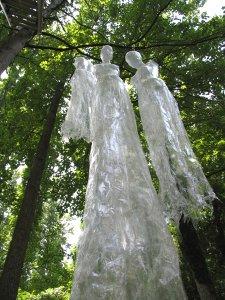
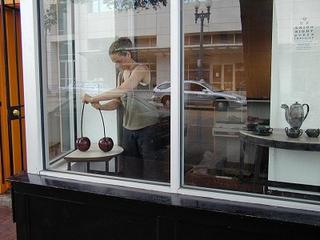

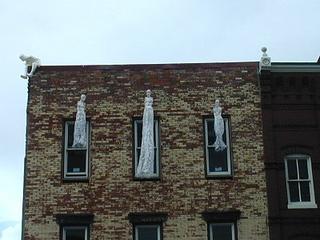
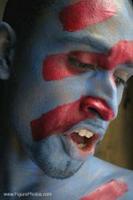

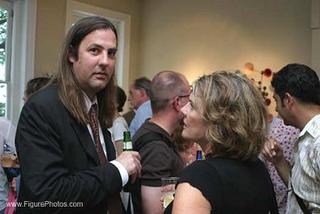
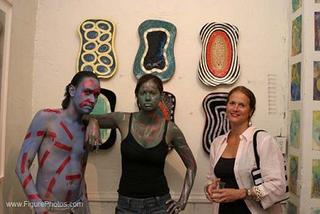
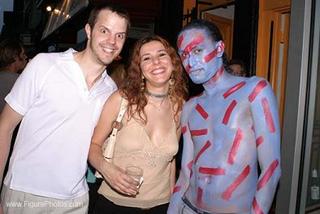

 CNN News will videotape coverage of Seven sometime next week.
CNN News will videotape coverage of Seven sometime next week.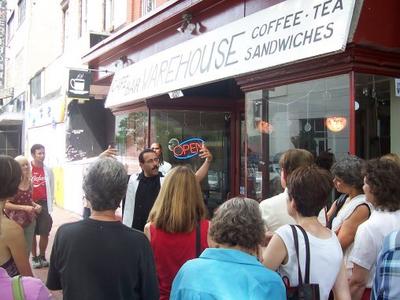
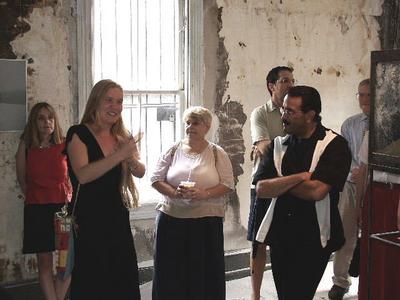
 This powerful painting, titled "Allegory of a Gay Bashing" by Scott Brooks has been receiving a lot of attention in the "nude gallery" in Seven. It is an homage by Brooks to the brutal murder of Matthew Sheppard.
This powerful painting, titled "Allegory of a Gay Bashing" by Scott Brooks has been receiving a lot of attention in the "nude gallery" in Seven. It is an homage by Brooks to the brutal murder of Matthew Sheppard.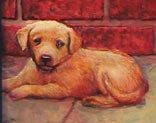 And to get to the beginning point of this ramble, in spite of the horror delivered by "Allegory of a Gay Bashing", many people get stuck on one area: the cute puppy and kitty at the bottom of the castrated nude.
And to get to the beginning point of this ramble, in spite of the horror delivered by "Allegory of a Gay Bashing", many people get stuck on one area: the cute puppy and kitty at the bottom of the castrated nude.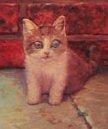 Cute kitty and cute puppy... taking the attention away from disturbing image. How dare Brooks paint cuteness, especially in this context?
Cute kitty and cute puppy... taking the attention away from disturbing image. How dare Brooks paint cuteness, especially in this context?